As artificial intelligence is rapidly evolving, AI voices are one of the most exciting and disruptive trends. From AI voice assistants like Siri and Alexa to more realistic voices used in podcast or audiobook storytelling and customer service bots, the way machines “speak” has become more natural-sounding, human vocal qualities, natural, and expressive than ever before. However, not all AI voices are the same. There are many distinct AI voice technologies, with disparate characteristics, purposes, and levels of realism.
With businesses, creators, and developers all attempting to take advantage of text-to-speech (TTS) systems, it is critical to understand the types of AI voices available to you. Depending on your use case, whether your goal is conversational tones, high-quality narration for broadcast, or multilingual dubbing, the choice of synthetic voice will greatly impact the effectiveness of the project.
If you’re exploring ways to bring these voices to life, don’t miss our detailed guide on the best AI voice generator tools available right now.
In this comprehensive overview, we’ll take a close look at the AI voices that are part of digital experiences, including text-to-speech voice types that mimic emotions, and highly realistic AI-generated voice examples. We’ll help you understand what is available, how they differ, and where they are best utilized. So, let’s jump right into the fantastic world of AI voice technology, where machines no longer just have data; they have your voice.
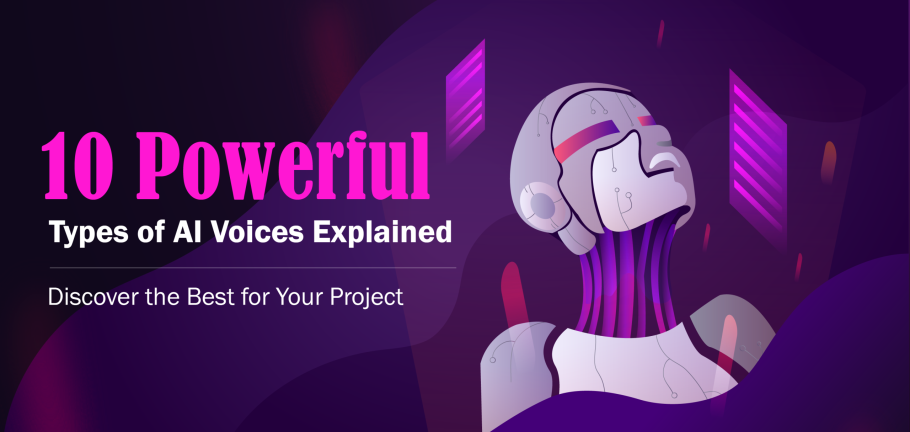
AI voices are not all the same. Some sound very real, some show emotion, and some can even sing or speak different languages. Each type is made for a different job — like audiobooks, customer service, or fun characters. This infographic gives you a quick and easy look at the 10 main types of AI voices that you’ll read about in this article.
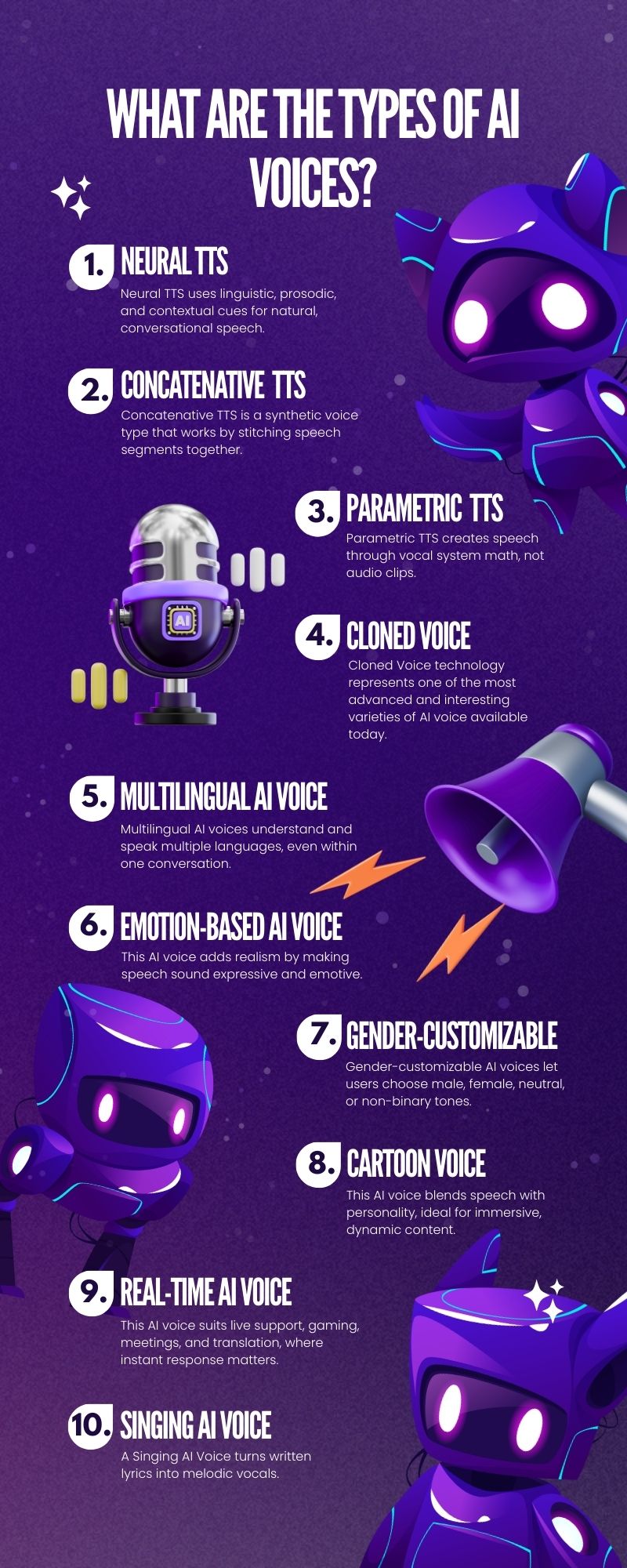
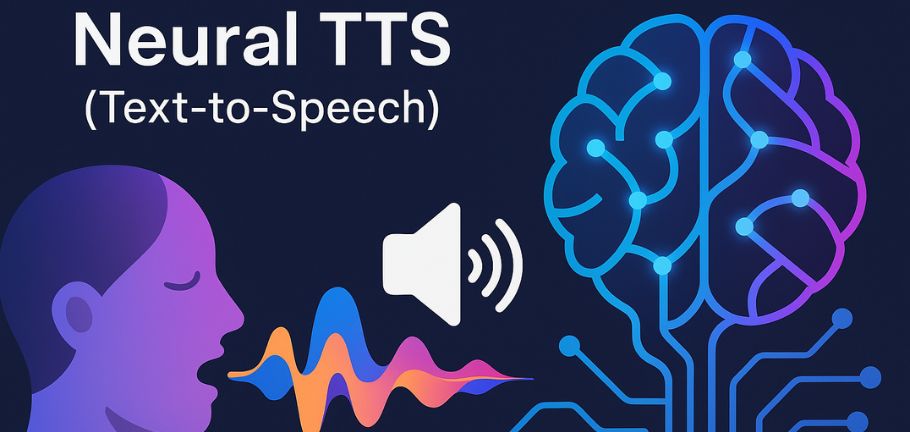
Neural TTS is the state-of-the-art in contemporary AI voice types. Utilizing deep learning and artificial neural networks, Neural Text-to-Speech synthesizes speech that is impressively human-like in clarity, rhythm, tone, and emotion, compared to older concatenative or parametric TTS methods. Neural TTS voices have expressive intonations and dynamic cadence, resembling authentic human speech.
Neural TTS combines machine learning models and natural language processing to interpret text inputs and produce highly realistic audio outputs. Neural TTS takes linguistic, prosodic, and contextual cues into consideration in order to produce speech that is less robotic and more conversational.
Key Features
- Naturalness: The hallmark of Neural TTS is its smooth, expressive delivery. It’s ideal for customer service bots, audiobooks, video dubbing, and voiceovers.
- Emotion-aware: Many Neural TTS engines now include emotional tuning, allowing voices to sound happy, sad, angry, or professional based on the use case.
- Multilingual support: Leading providers offer multilingual and multi-accent capabilities using a single model architecture.
Popular services such as Amazon Polly Neural, Google Cloud’s WaveNet, and Microsoft Azure TTS have produced AI-generated voices that are so realistic that it’s hard to tell they are not human voices unless you are trained to hear the difference.
| Application | Why Neural TTS Fits |
|---|---|
| Audiobooks | Lifelike narration improves engagement |
| E-learning | Clear, expressive tone aids understanding |
| Call centers | Enhances customer interaction quality |
| Content creation | High-quality voiceovers without hiring talent |
Neural TTS is transforming the landscape of digital communication. As the demand for scalable, AI-generated voice solutions increases, this type of synthetic voice is finding its place in the mix due to its diversity and emotional depth. It’s more than simply reading text; it’s about creating engaging, immersive voice experiences.
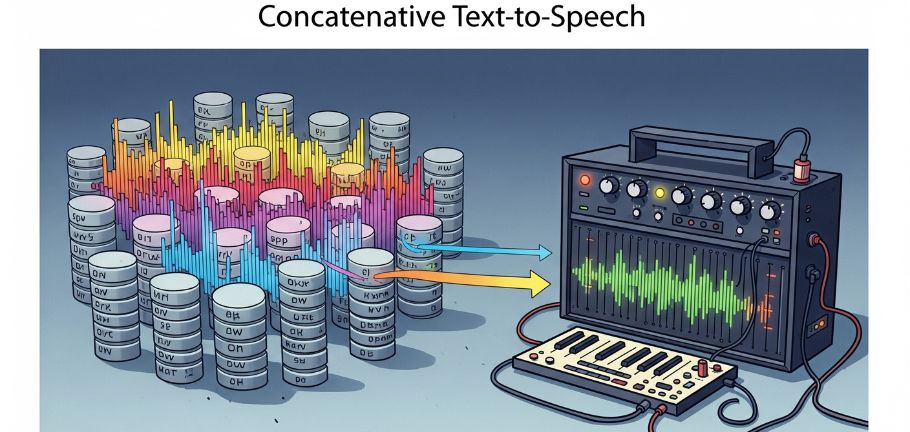
Prior to deep learning or Neural TTS, Concatenative TTS was the mainstay of AI voice types. Although older, this method was the precursor to modern text-to-speech voice styles and introduced stringing pre-recorded human speech segments together to produce whole sentences.
Concatenative TTS is a synthetic voice type that works by stitching speech segments together. It uses a database of audio recordings and selects which recordings go together based on the text input to create speech.
Unlike neural models, Concatenative doesn’t “generate speech in real-time,” it simply plays snippets of pre-recorded audio. Because of this, Concatenative TTS often sounds robotic, especially with different contexts or emotional tones.
Key Features
- High clarity with limited flexibility: When recordings match the text perfectly, the output can sound quite clear. But deviations often result in choppy or unnatural phrasing.
- Limited emotional range: Because it relies on pre-recorded samples, there’s little room for emotion or dynamic expression.
- Language constraints: Requires a separate, large dataset of recordings for every language or dialect.
While Concatenative TTS is largely being replaced by neural methods, some legacy systems and budget platforms still use it, especially where real-time processing or emotion-rich output isn’t a priority.
Examples include:
- Older versions of Apple’s Siri
- Early GPS navigation voices
- Basic automated phone menus
| Application | Why Concatenative TTS Fits |
|---|---|
| IVR phone systems | Functional clarity without needing emotional nuance |
| Basic accessibility tools | Offers low-cost speech solutions with acceptable quality |
| ATMs and kiosks | Pre-defined phrases work well with limited variability |
While Concatenative TTS is considered outdated in terms of today’s TTS systems, Concatenative TTS was instrumental in the development of types of AI voices. Knowing the structure of Concatenative TTS allows us to value how much it has improved since then with the Neural TTS approach. Concatenative TTS and its format are still part of the framework of types of AI voice systems, especially in low-resource or less tech-savvy environments.
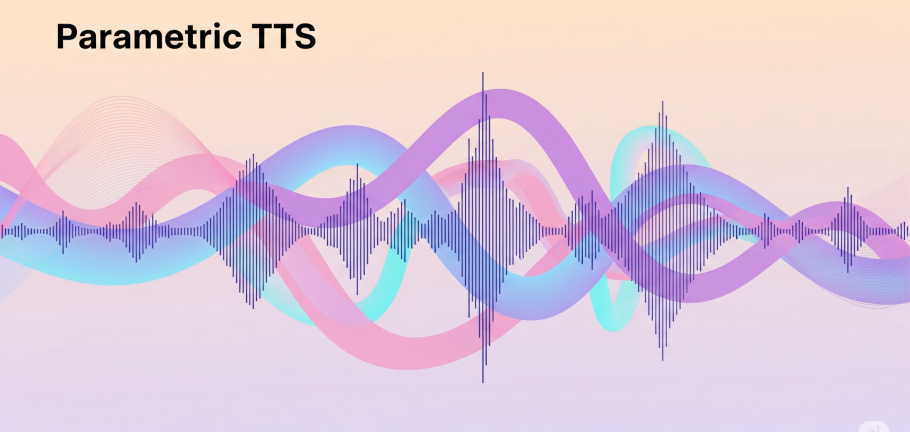
Parametric TTS represents an early development of text-to-speech voice styles, developed to be less rigid and adaptable than Concatenative TTS, which can require massive amounts of data. While outdated and largely superseded by Neural TTS, Parametric TTS helped to make the style of AI voice type more flexible, customizable, and scalable for different applications.
Parametric TTS synthesizes speech by modeling the human vocal system with mathematical formulas, rather than joining limited pre-recorded audio segments. It works by using parameters, such as pitch, duration, and frequency, to create the voice from scratch. This allows for a smaller and more flexible system load, but it sounds unnatural when compared to modern methods designed for a more realistic audio output.
Key Features
- Small footprint: Ideal for embedded systems and low-power devices due to its compact model size.
- Highly customizable: Voice pitch, speed, and tone can be altered in real time, allowing for some level of personalization.
- Synthetic tone: While intelligible, the voice output lacks the emotional and expressive nuance of Neural TTS, often sounding flat or robotic.
While rare in consumer-facing products today, Parametric TTS still exists in legacy systems:
- Basic automated announcements in transport hubs
- Early speech-enabled mobile apps
- Talking devices for accessibility before 2010
These examples show how synthetic voice types evolved from function-first models to more expressive, human-like solutions.
| Application | Why Parametric TTS Fits |
|---|---|
| Embedded devices | Lightweight design works well in hardware-limited systems |
| Budget-friendly apps | Easy to implement where naturalness isn't a top priority |
| Accessibility technology | Offers spoken feedback with low resource usage |
Parametric TTS opened the door to the current era of synthetic voices. Although it had limited expressiveness, it was a landmark in the development of different types of AI voice because it could convert speech on the fly without terabytes of data. Knowing parametric TTS models’ place in AI voice helps us understand modern voice solutions’ vast improvement in quality.
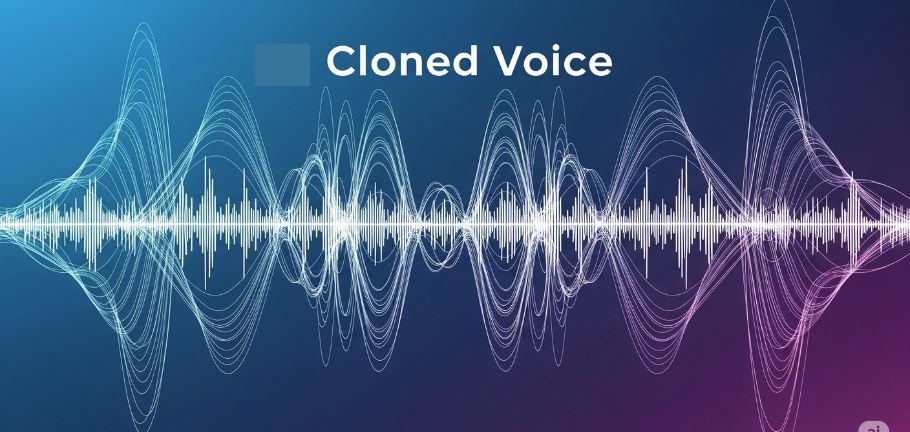
Cloned Voice technology represents one of the most advanced and interesting varieties of AI voice available today. By duplicating a particular person’s voice patterns, tone, pitch, and, in some cases, way of speaking, AI can produce synthetic speech that closely resembles the original speaker’s voice, just like the original speaker’s voice.
Cloned Voice is created using voice cloning algorithms that utilize machine learning models on audio recordings of a person. As little as a few minutes with great quality of speech data can lead to a voice that can reproduce someone’s voice, pacing, accent, and emotion when speaking.
This AI voice technology is part of a widespread move toward greater personalization and humanization of digital content (including voice branding) and entertainment.
Key Features
- Personalized output: Creates voices tailored to a specific individual, celebrities, executives, or content creators.
- High realism: Advanced cloning models can replicate emotions, pauses, inflections, and even imperfections.
- Multi-language cloning: Some platforms can now recreate a cloned voice speaking in multiple languages, preserving its unique identity across translations.
Top platforms showcasing AI-generated voice examples using cloning include:
- ElevenLabs – Offers emotional, multilingual voice cloning with short training data.
- Resemble.ai – Known for real-time voice cloning with API support.
- Speech and Play.ht – Offer custom voice options for branding and commercial use.
These tools demonstrate how text-to-speech voice styles are evolving from generic tones to recognizable, brand-aligned voices.
| Application | Why Cloned Voice Fits |
|---|---|
| Brand voiceovers | Consistent voice identity for ads, videos, and support bots |
| Audiobook narration | Authors can narrate their books without extended recording |
| Personalized assistants | Custom voice interactions in apps or smart devices |
| Post-production dubbing | Recreate the original actor's voice in different languages |
Cloned Voice is a highly personal type of AI voice that gives creators, brands, and even individuals a way to replicate their voice through many different mediums and languages. With the increase in synthetic voice technologies and their advances, cloned voice technology is the leading edge of AI-generated voice examples, which are identifiable and realistic.
However, there are real ethical and legal issues related to concerns about misuse. Responsible use, consent, and transparency are important when using this synthetic voice type.
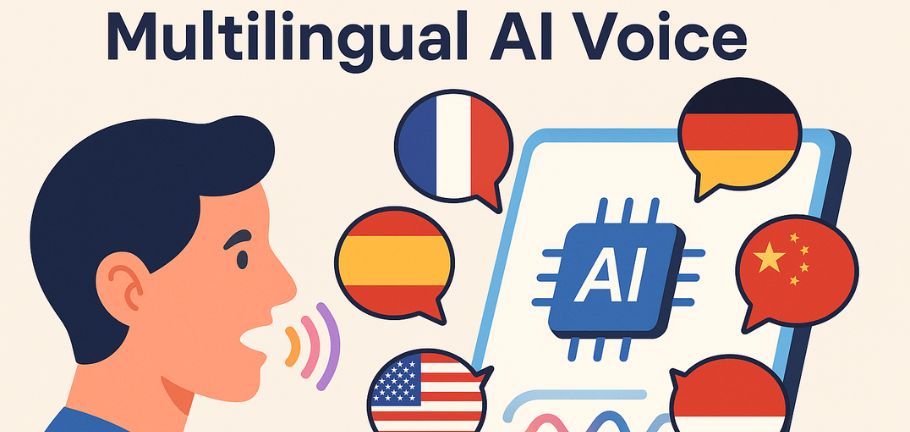
In a world that is highly globalized and interconnected today, communicating with people who speak different languages is a requirement rather than a luxury. Multilingual AI Voice is among the most flexible and diverse types of AI voices, aimed at removing the language barrier while keeping the integrity of natural speech in terms of flow, tone, and intention.
Multilingual AI voices are advanced text-to-speech voice types that are able to both comprehend and produce multiple languages, sometimes during the same conversation or project. Multilingual AI Voices are trained on large, diverse samples of linguistic data and can transition amongst different languages, while maintaining both the structure and undertones of spoken language.
This makes the type of AI voice critical to international businesses and global content creators, education, and, of course, accessibility applications.
Key Features
- Multi-language fluency: Can read and synthesize speech in various languages, including English, Spanish, Mandarin, Arabic, French, and more.
- Accent retention: Some advanced engines can retain a speaker’s accent across different languages, providing a natural bilingual flow.
- Seamless code-switching: Ideal for multilingual regions where switching languages mid-sentence is common.
Leading platforms offering impressive AI-generated voice examples with multilingual support include:
- Google Cloud Text-to-Speech – Offers over 220 voices across 40+ languages and variants.
- Amazon Polly – Provides real-time multilingual output with accent control.
- Papercup – Specializes in dubbing videos using multilingual synthetic voices for global reach.
These platforms exemplify how different types of AI voice technologies are expanding the possibilities for content localization and voice accessibility.
| Application | Why Multilingual AI Voice Fits |
|---|---|
| Global video content | Instantly dub content in multiple languages |
| E-learning platforms | Deliver training to international audiences seamlessly |
| Customer support bots | Serve diverse users in their native language |
| Public service announcements | Communicate with multicultural communities effectively |
Multilingual AI Voice is a revolutionary development for ensuring digital content is universally accessible. It supports inclusion, improves user experience, and avoids multiple voice recordings in different languages altogether. As businesses grow in a global context, multilingual AI voice allows them to communicate locally while working on a global level.
Additionally, it enables those who are not native speakers to interact with technology and confidence, allowing AI voice types to have more equitable representation and impact on people across a variety of cultures and languages.
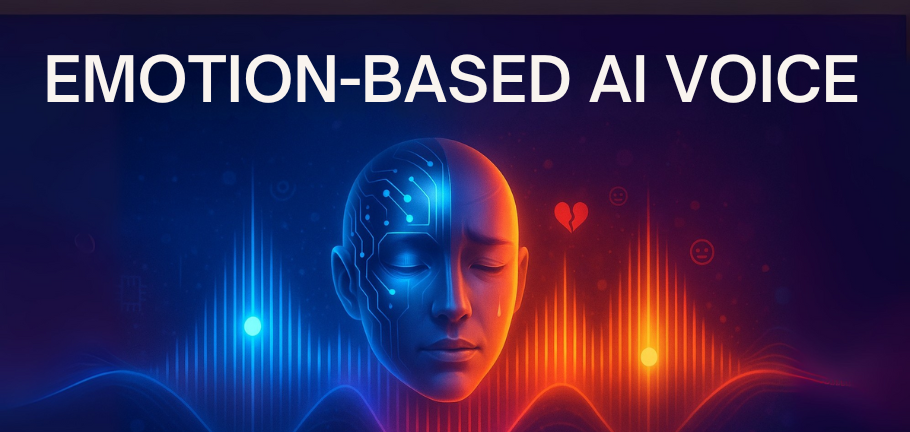
In a world driven by storytelling, tone matters as much as words. That’s why Emotion-Based AI Voice technology is rapidly gaining attention as one of the most expressive and human-like types of AI voices. These voices don’t just deliver information; they convey emotion, making digital interactions feel more personal, relatable, and engaging.
An Emotion-Based AI Voice is an advanced text-to-speech voice style designed to replicate human emotions such as happiness, sadness, excitement, anger, or calmness. These models use deep learning techniques to analyze vocal tone, pacing, inflection, and context, generating speech that mirrors the emotional depth of human communication.
This AI voice type enhances the authenticity and effectiveness of audio content by allowing machines to “feel” in their delivery, at least in how they sound.
Key Features
- Emotion control: Choose from a range of emotional tones, cheerful, empathetic, disappointed, excited, based on the content or situation.
- Context awareness: Adjusts intonation depending on the meaning and sentiment of the sentence.
- Realistic expression: Mimics not only tone but also natural pauses and intensity for a believable listening experience.
Several top-tier platforms offer AI-generated voice examples with emotional layers:
- Microsoft Azure TTS – Offers “Neural Voice Styles” like friendly, angry, hopeful, or sad.
- Play.ht and Murf.ai – Enable emotional toggling for voiceovers and narration.
- Descript Overdub – lets you insert emotionally nuanced voice snippets into videos or podcasts.
These platforms highlight the potential of synthetic voice types to revolutionize storytelling, branding, and digital communication.
| Application | Why Emotion-Based AI Voice Fits |
|---|---|
| Podcast narration | Brings stories to life with dramatic vocal expression |
| Mental health chatbots | Empathetic tones enhance user trust and comfort |
| Audiobooks & animations | Characters feel real, boosting listener immersion |
| Customer service responses | Emotional awareness improves customer satisfaction |
Traditional TTS often lacks the emotional intelligence that human interaction requires. Emotion-Based AI Voice technology bridges this gap by adding expressive realism to digital speech. Whether it’s a customer service agent sounding reassuring or a narrator building suspense, this AI voice type transforms flat, robotic delivery into emotionally charged communication.
As one of the most promising different types of AI voice solutions, emotion-based TTS has the power to evoke empathy, establish brand tone, and build deeper human-machine connections.

As inclusivity and personalization take center stage in technology, Gender-Customizable AI Voice has emerged as a vital innovation among the types of AI voices. It empowers users to choose the gender identity of the voice they interact with, breaking free from the binary limitations of traditional voice systems and embracing diversity.
A Gender-Customizable AI Voice allows users to select or adjust the gender presentation of the AI-generated voice, male, female, neutral, or even non-binary options. These text-to-speech voice styles are often powered by neural models that offer fine-grained control over pitch, tone, resonance, and speech patterns.
Rather than assigning static gender labels, this AI voice type enables dynamic customization based on brand preference, user identity, or cultural norms.
Key Features
- Flexible identity settings: Choose from a spectrum of gendered and gender-neutral voices.
- Voice tuning options: Modify elements like pitch, timbre, and speed to align with preferred vocal characteristics.
- Inclusivity-first design: Offers a more representative range of voices for diverse audiences.
Leading platforms that provide AI-generated voice examples with gender customization include:
- Google’s DeepMind – Introduced gender-neutral voice models like “Q” for broader representation.
- Resemble.ai – Allows fine-tuning of voice traits across a gender spectrum.
- WellSaid Labs and Play.ht – Offer a variety of male, female, and neutral TTS voices for narration and branding.
These platforms highlight the shift from one-size-fits-all voices to a more inclusive library of synthetic voice types.
| Application | Why Gender-Customizable AI Voice Fits |
|---|---|
| Virtual assistants | Align voice persona with brand values or target audience |
| Educational platforms | Let learners choose a voice they feel most comfortable with |
| Healthcare & mental wellness | Create a supportive experience with gender-aligned voices |
| Marketing & branding | Match voice tone to campaign demographics or brand identity |
Gender-Customizable AI Voice technology isn’t just about choice; it’s about representation, identity, and connection. In an age where personalization and inclusivity define user experience, this AI voice type ensures that everyone feels seen and heard.
For developers and brands, offering gender options reflects social awareness and builds stronger user trust. As more users seek relatable digital interactions, different types of AI voice solutions like this become essential for creating respectful, inclusive communication.
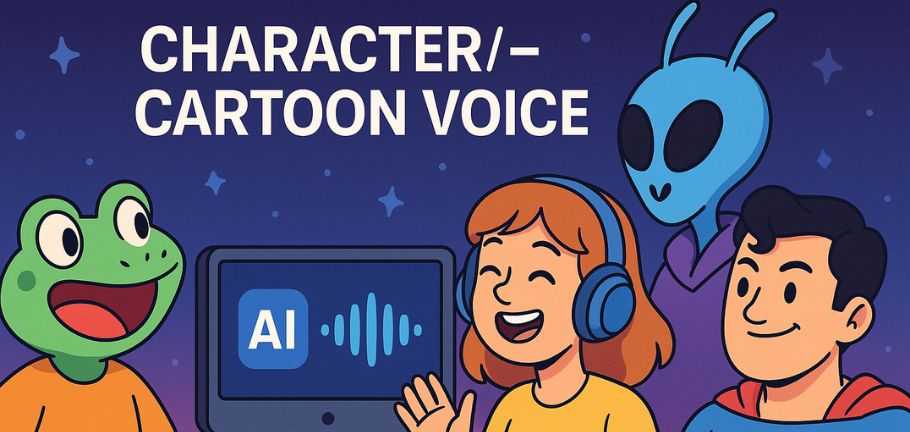
When it comes to entertainment, gaming, animation, and storytelling, a generic voice just won’t do. Enter Character or Cartoon Voices, one of the most creative and specialized types of AI voices designed to bring fictional characters to life with style, flair, and personality.
A Character/Cartoon AI Voice is a synthetic voice modeled with exaggerated tones, unique vocal traits, and animated expressiveness. These voices don’t aim to sound natural in a human sense; instead, they’re built to entertain, exaggerate, and sometimes even parody. They are often customized to fit a character’s identity, whether it’s a whimsical animal, a superhero, or a talking alien.
This AI voice type combines voice synthesis with personality simulation, often used in dynamic, immersive content.
Key Features
- Distinct personality: Voices are infused with quirks, catchphrases, or exaggerated tones to suit specific character roles.
- Pitch and pace variation: Allows for creative manipulation, squeaky, deep, fast-talking, goofy, or spooky.
- Emotionally expressive: Even with their cartoonish quality, these voices often convey strong emotions like excitement, fear, or curiosity.
Leading platforms producing AI-generated voice examples for character-style voices include:
- Voicemod – Offers real-time cartoon voice filters and voice packs.
- Lovo.ai – Features character presets suitable for gaming and animation.
- Descript and Murf.ai – Let users tweak tones and styles to suit fictional or exaggerated personas.
These tools help creators unlock fun, custom text-to-speech voice styles that go beyond standard narration.
| Application | Why Character AI Voice Fits |
|---|---|
| Animated series | Brings animated characters to life with fitting voice traits |
| Video games | Enhances immersion through unique character dialogue |
| Children's audiobooks | Keeps kids engaged with playful and dynamic vocal tones |
| YouTube and content creation | Adds humor and flair to storytelling or tutorials |
Character AI Voices are more than just fun; they’re a storytelling tool. In an era where content must captivate quickly, these synthetic voice types offer creators a way to entertain and engage through voice. Whether you’re crafting an epic quest or a goofy cartoon skit, this AI voice type turns static dialogue into memorable characters.
As one of the more creative different types of AI voices, character voices showcase how AI can fuel imagination, not just automation.
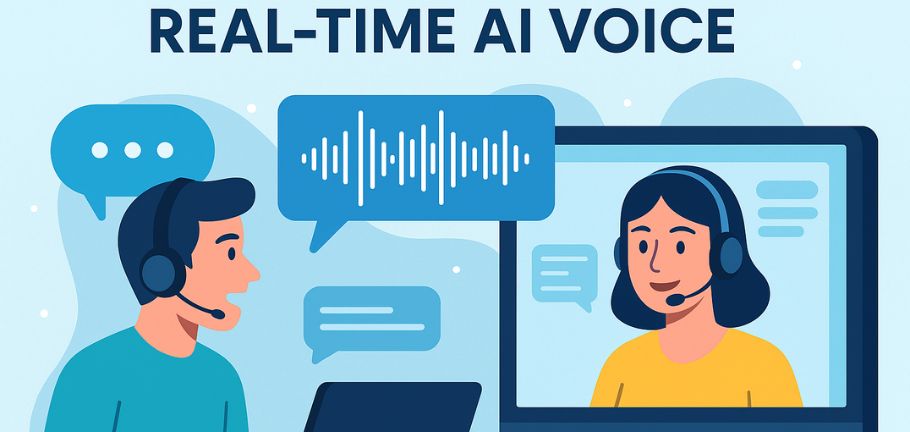
In fast-paced digital environments where speed and responsiveness matter, Real-Time AI Voice has become a groundbreaking innovation among the types of AI voices. It enables instant speech synthesis with minimal latency, allowing AI systems to “speak” in real time, just like a human in a live conversation.
A Real-Time AI Voice refers to AI-generated voice examples that are produced and streamed with a sub-second delay. These voices use highly optimized neural networks and processing pipelines to convert text or audio prompts into natural-sounding speech instantly.
This AI voice type is ideal for dynamic applications like live customer support, virtual meetings, gaming, and real-time translation services, where immediate feedback is critical.
Key Features
- Low latency: Converts text into speech almost instantly, usually under 300 milliseconds.
- Interactive dialogue: Enables natural, back-and-forth conversations without awkward pauses.
- Streaming output: Voice is generated continuously as input is received, making it seamless for live use.
Several platforms offer text-to-speech voice styles capable of real-time interaction:
- Amazon Polly (Neural Streaming) – Offers near-instant audio generation for chatbots and devices.
- Microsoft Azure TTS (Low-latency mode) – Enables live voice generation for conversational bots.
- Inworld and Altered.ai – Power interactive NPCs in video games and immersive VR.
These examples highlight the growing demand for synthetic voice types that respond as fast as they sound realistic.
| Application | Why Real-Time AI Voice Fits |
|---|---|
| Customer service bots | Immediate voice replies improve satisfaction and efficiency |
| Interactive gaming | NPCs respond with realistic timing and tone |
| Live video conferencing | AI moderators or assistants speak naturally in real time |
| Real-time translation tools | Translate and vocalize conversations instantly |
Real-Time AI Voice technology is redefining how we interact with machines. By eliminating lag and enabling fluid conversations, this AI voice type enhances the realism and usability of digital assistants, gaming avatars, and virtual support agents. It also strengthens the emotional engagement of real-time applications by delivering AI-generated voice examples that respond like a real person would.
As industries push toward more immersive, responsive AI, different types of AI voice solutions like real-time synthesis are becoming the cornerstone of next-gen digital communication.
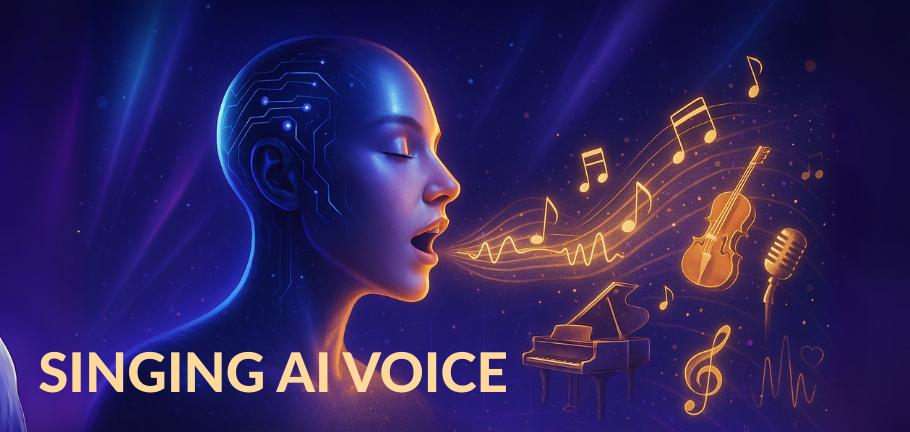
Pushing the boundaries of synthetic audio beyond spoken language, Singing AI Voice is one of the most exciting and creative types of AI voices. These voices are not only capable of delivering lyrics but can replicate pitch, rhythm, vibrato, and emotional tone, bringing music to life with impressive realism.
A Singing AI Voice is a specialized text-to-speech voice style that transforms written lyrics into melodic vocal performances. Using advanced neural networks, often trained on large datasets of human singing in various genres and vocal ranges, the AI can generate songs that mimic human singers in multiple languages and tones.
Unlike standard TTS, singing voices require complex modeling of musical structure, including tempo, phrasing, pitch control, and stylistic ornamentation.
Key Features
- Musical pitch modeling: Adjusts voice to follow musical notes with accurate intonation.
- Dynamic expression: Captures nuances like breathiness, vibrato, and dynamic shifts.
- Genre versatility: Supports various musical styles, pop, classical, rock, hip-hop, and more.
- Language flexibility: Can perform multilingual songs while retaining tonal quality.
Several platforms now showcase AI-generated voice examples tailored for musical applications:
- Voicemod AI Music – Offers real-time singing filters with pitch and harmony control.
- Synthesizer V – Used by vocal synth communities for professional-quality songs.
- Hatsune Miku AI (from Yamaha) – A famous example of an AI generated singing voice used in concerts and albums.
These tools are revolutionizing the music industry, allowing creators to compose vocals without hiring singers or booking studios.
| Application | Why Singing AI Voice Fits |
|---|---|
| Music production | Generate demo vocals or full songs instantly |
| Video content creation | Add musical segments without a singer |
| Jingles and ad campaigns | Custom musical branding on a budget |
| Interactive entertainment | Singing chatbots or game characters with personality |
Singing AI Voices open the door to limitless creative possibilities in entertainment, marketing, and content creation. As one of the most artistic synthetic voice types, they’re democratizing music production, enabling anyone with an idea to bring a melody to life, regardless of vocal ability.
Moreover, this innovation blurs the line between human and machine expression, showcasing just how far AI voice types have come, from reading text to singing soulfully.
| AI Voice Type | Brief Definition | Common Use Cases | Unique Attributes |
|---|---|---|---|
| 1. Neural TTS | Uses deep learning to generate highly natural, human-like speech. | Audiobooks, e-learning, voice assistants, dubbing | Emotion-aware, multilingual, realistic |
| 2. Concatenative TTS | Combines pre-recorded sound clips to form words and sentences. | IVRs, ATMs, and basic GPS voices | Clear but limited flexibility, outdated for modern UX |
| 3. Parametric TTS | Synthesizes speech using mathematical parameters, instead of recorded audio. | Accessibility tools, embedded systems, and budget apps | Lightweight, customizable pitch and tone, robotic sounding |
| 4. Cloned Voice | AI replicates a specific person's voice from voice samples. | Branding, audiobooks, virtual assistants, dubbing | Identical to real voices, personalization, and ethical concerns |
| 5. Multilingual AI Voice | Speaks and understands multiple languages with localized pronunciation. | Global content, e-learning, customer support, marketing | Language switching, accent retention, and inclusive design |
| 6. Emotion-Based Voice | Delivers speech with emotional expression (happy, sad, excited, etc.). | Customer service, storytelling, healthcare bots, voiceovers | Enhances engagement, builds empathy, and contextual tone control |
| 7. Gender-Customizable Voice | Allows selection of male, female, or gender-neutral voices. | Smart devices, apps, inclusive branding, and educational tools | Personalized UX, supports gender diversity, flexible design options |
| 8. Character/Cartoon Voice | AI voices with stylized traits for animated or fictional characters. | Games, animation, children's books, YouTube skits | Fun, exaggerated, creative storytelling potential |
| 9. Real-Time AI Voice | Produces and streams AI speech instantly with low latency. | Live chatbots, games, conferencing, and translation tools | Interactive Responsive, interactive, sub-second delay voice generation |
| 10. Singing AI Voice | Converts lyrics into music using singing pitch and rhythm modeling. | Music production, jingles, virtual idols, ad campaigns | Genre versatility, emotion in music, voice-to-song capability |
As synthetic voice technology continues to evolve, the benefits of integrating AI voice types into your content, services, or products have become increasingly clear. Whether you’re a business owner, content creator, or developer, here are the key advantages of using AI-generated voices.
Creating voiceovers traditionally involves scheduling talent, booking studio time, and undergoing multiple rounds of editing. With AI voices, this process is reduced to minutes. Simply input text, select a text-to-speech voice style, and generate audio instantly. This makes AI ideal for rapid content deployment.
Hiring professional voice actors for multiple projects, languages, or updates can be expensive. AI voice types eliminate recurring voice talent costs while maintaining consistent quality. This is particularly valuable for startups, educators, marketers, and global businesses working on a budget.
Need to generate thousands of voiceovers for a product catalog, eLearning platform, or localized content? No problem. AI voice tools scale effortlessly, allowing creators to produce massive amounts of voice content in bulk, something manual methods can’t compete with.
Modern synthetic voice types now include emotion-based customization, letting users generate speech that sounds happy, calm, persuasive, or empathetic. This feature improves storytelling, customer support, and user experience by delivering the right tone for the right context.
Multilingual AI voices are breaking barriers by offering native-like pronunciation across dozens of languages. Brands can now localize video, apps, websites, and services without hiring different voice actors for each language, while still keeping tone and messaging consistent.
The evolution of AI voice types has revolutionized how we interact with technology, consume content, and deliver experiences. From the natural-sounding fluency of Neural TTS to the imaginative flair of character and cartoon voices, each voice model serves a unique purpose. Whether you’re designing a virtual assistant, producing YouTube content, or building an e-learning course, understanding the different types of AI voice options is crucial for selecting the right tone, delivery, and emotional expression.
What makes synthetic voice types so impactful is their versatility and scalability. Businesses can localize content with multilingual AI voices, personalize user experiences with cloned or gender-customizable voices, and even add emotional nuance to digital communication. These voices not only save time and reduce costs, but also enhance user engagement by delivering the right message with the right mood, every single time.
As AI continues to advance, the capabilities of text-to-speech voice styles will only grow more dynamic and inclusive. Choosing the right AI voice isn’t just a technical decision; it’s a creative one that influences how audiences perceive and connect with your brand or content. Now is the time to embrace these innovations and give your ideas a voice that truly resonates.
⚠️ Disclaimer: Voice cloning AI tools should be used responsibly and only with the speaker’s consent. Unauthorized use may lead to legal, ethical, or copyright violations. Always consult legal advice when using voices commercially.
What are the main types of AI voices?
The main types of AI voices include Neural TTS, Concatenative TTS, Parametric TTS, Cloned Voice, Multilingual AI Voice, Emotion-Based Voice, Gender-Customizable Voice, Character/Cartoon Voice, Real-Time AI Voice, and Singing AI Voice. Each type serves different purposes, from realistic narration and multilingual communication to entertainment and branding.

What is Neural TTS in AI voices?
Neural TTS (Text-to-Speech) is an advanced voice synthesis technology that uses deep learning to generate speech that closely mimics natural human voices. It offers expressive intonation, emotion, and contextual awareness, making it one of the most popular and realistic AI voice types available today.

I’m Kashan Chishty, CEO of Concept Beans and a serial entrepreneur with over 25 years of experience in design, user experience, & digital innovation. I’ve successfully founded companies across the USA and Asia, including Dropesy, Affordable Pvt Ltd, and Concept Beans. My core expertise includes AI video generation, UX audits, product design, & strategic digital marketing.
Is there a difference between male and female AI voices?
Yes. AI voice platforms typically offer a range of gender-customizable voices, including male, female, and even gender-neutral options. These differences affect tone, pitch, cadence, and style, allowing brands and developers to align voices with their intended audience or identity.

I’m Kashan Chishty, CEO of Concept Beans and a serial entrepreneur with over 25 years of experience in design, user experience, & digital innovation. I’ve successfully founded companies across the USA and Asia, including Dropesy, Affordable Pvt Ltd, and Concept Beans. My core expertise includes AI video generation, UX audits, product design, & strategic digital marketing.
What is the most natural-sounding AI voice type?
Neural TTS is widely considered the most natural-sounding among all synthetic voice types. It replicates human speech patterns, emotional tone, and pacing with impressive accuracy. Many platforms also allow emotional styling, making the voice even more lifelike.

I’m Kashan Chishty, CEO of Concept Beans and a serial entrepreneur with over 25 years of experience in design, user experience, & digital innovation. I’ve successfully founded companies across the USA and Asia, including Dropesy, Affordable Pvt Ltd, and Concept Beans. My core expertise includes AI video generation, UX audits, product design, & strategic digital marketing.
What tools offer different AI voice types?
Popular tools that offer various AI voice types include Amazon Polly, Google Cloud Text-to-Speech, Microsoft Azure TTS, ElevenLabs, Murf.ai, and Resemble.ai. These platforms provide features like real-time synthesis, multilingual support, emotional tone, and custom voice cloning.

I’m Kashan Chishty, CEO of Concept Beans and a serial entrepreneur with over 25 years of experience in design, user experience, & digital innovation. I’ve successfully founded companies across the USA and Asia, including Dropesy, Affordable Pvt Ltd, and Concept Beans. My core expertise includes AI video generation, UX audits, product design, & strategic digital marketing.

I’m Kashan Chishty, CEO of Concept Beans and a serial entrepreneur with over 25 years of experience in design, user experience, & digital innovation. I’ve successfully founded companies across the USA and Asia, including Dropesy, Affordable Pvt Ltd, and Concept Beans. My core expertise includes AI video generation, UX audits, product design, & strategic digital marketing.